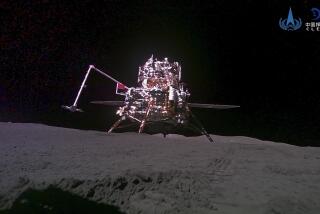Return of the Jade Rabbit: China’s moon rover back in action
BEIJING -- China’s Jade Rabbit lunar rover, feared to have suffered some irreparable technical difficulties, may yet have some spring in its step.
In late January, Chinese authorities said the rover -- which arrived on the moon in mid-December -- had experienced mechanical abnormalities just before it was to enter a two-week dormancy during the moon’s long, frigid night.
The moon buggy, anthropomorphized through a microblog account, sent out some bleak but stoic messages about its apparently dire fate:
“Masters are working round the clock. In spite of that, I know I might not be able to make it through this lunar night,” read one message from Jan. 25. “If this journey is to be suspended ahead of schedule, I am not fearful. Whether I can be fixed or not, I believe I have left my masters much valuable information and experience.”
During the lunar night and planned dormancy, scientists were unable to tell whether the Jade Rabbit could be fixed. With the lunar night having ended last week, anticipation was building for word from the rover.
On Wednesday, China’s state-run media carried a terse item stating that the Jade Rabbit “could not be restored to full function on Monday as expected,” adding that citizens were mourning it online.
But on Thursday morning, the Jade Rabbit’s microblog pinged out a new message: “Hi, anyone there?”
The state-run New China News Agency later quoted space program spokesman Pei Zhaoyu as saying that the rover had “come back to life” and was sending and receiving messages but that scientists were still investigating its mechanical difficulties.
Chinese authorities have not offered specifics on the problems, though several overseas-based space-related websites have said a solar panel failed to fold and close, perhaps leaving the rover’s instrumentation exposed to extremely low temperatures.
The Jade Rabbit was carried to the moon by China’s Chang’e 3 spacecraft, the first spacecraft to make a soft landing on the lunar surface in nearly four decades. The last one before that was the Soviet Union’s Luna 24 mission, sent to collect samples in 1976.
Chang’e 3 is named after a Chinese moon goddess, and the rover is named after her rabbit companion.
Since landing, the lander and rover have been surveying the lunar surface and conducting experiments. The rover has analyzed the lunar soil, and the lander -- equipped with an optical telescope and ultraviolet camera -- has observed the Earth’s plasmasphere and sent back pictures of the rover.
Initial plans for the rover called for it to survive at least three months on the moon.
Tommy Yang in the Times’ Beijing bureau contributed to this report.







